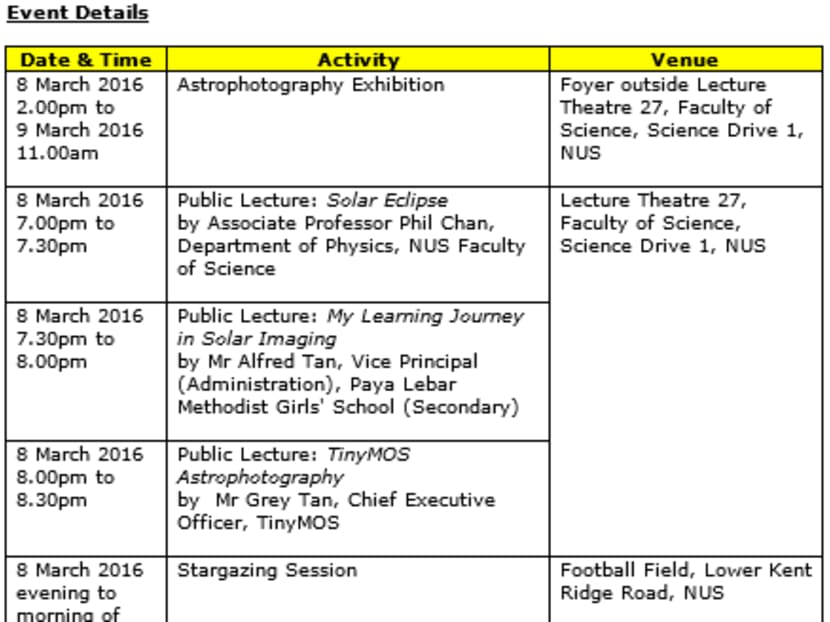Rare astronomical event: Singapore to experience partial solar eclipse on March 9
SINGAPORE — Get ready for a rare and special astronomical event next month. On March 9, a partial solar eclipse will be visible in Singapore, with nearly 90 per cent of the sun being obscured by the moon at the point of maximum eclipse.
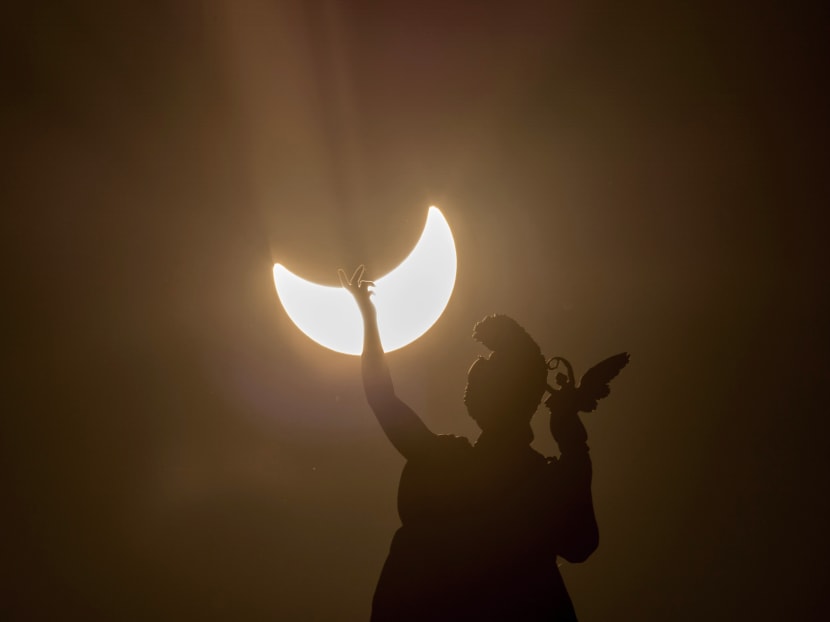
A partial solar eclipse is visible over a statue located at the rooftop of Austrian Art History Museum in Vienna on March 20, 2015. Photo: AFP
SINGAPORE — Get ready for a rare and special astronomical event next month. On March 9, a partial solar eclipse will be visible in Singapore, with nearly 90 per cent of the sun being obscured by the moon at the point of maximum eclipse.
According to Science Centre Singapore, next month’s eclipse will begin at around 7.22am, 10 minutes after sunrise. The point of maximum eclipse will be around 8.23am and the eclipse will end at 9.33am.
At the point of maximum eclipse, the sky should be similar to evening brightness, Dr Abel Yang, a Lecturer from the Department of Physics at the National University of Singapore, told TODAY.
However as the sun is being progressively obscured by the moon, there will not be a sudden drop in the sun’s brightness, Dr Yang said. “For someone who is not actively watching out for the eclipse, it would seem as if the morning twilight is longer than usual,” he explained.
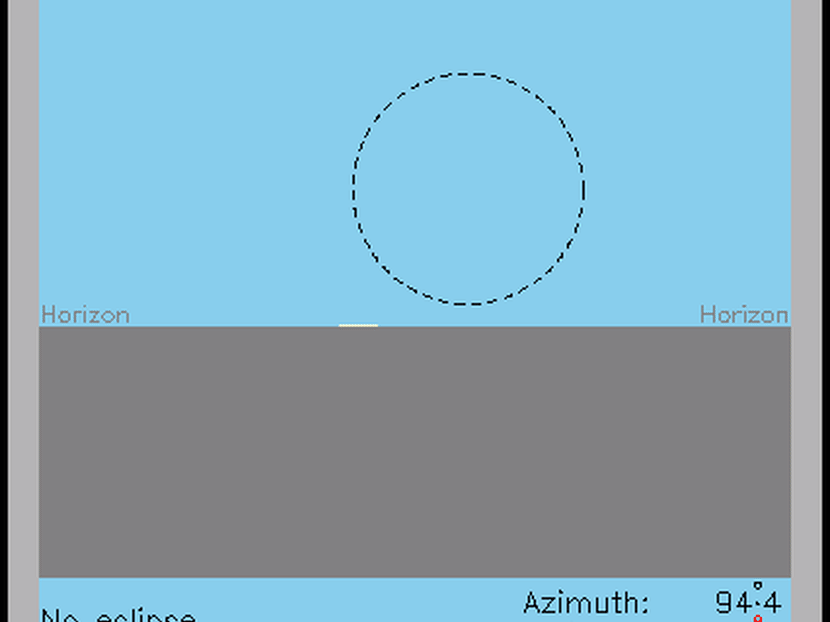
(Photo: HM Nautical Almanac Office)
The eclipse will be visible from anywhere in Singapore that has a clear view of the eastern horizon, at a compass heading of approximately 94°, said the Science Centre.
As a general tip, make sure there are no trees or buildings in your way, especially since the sun will still be low when the eclipse starts, said Dr Yang.
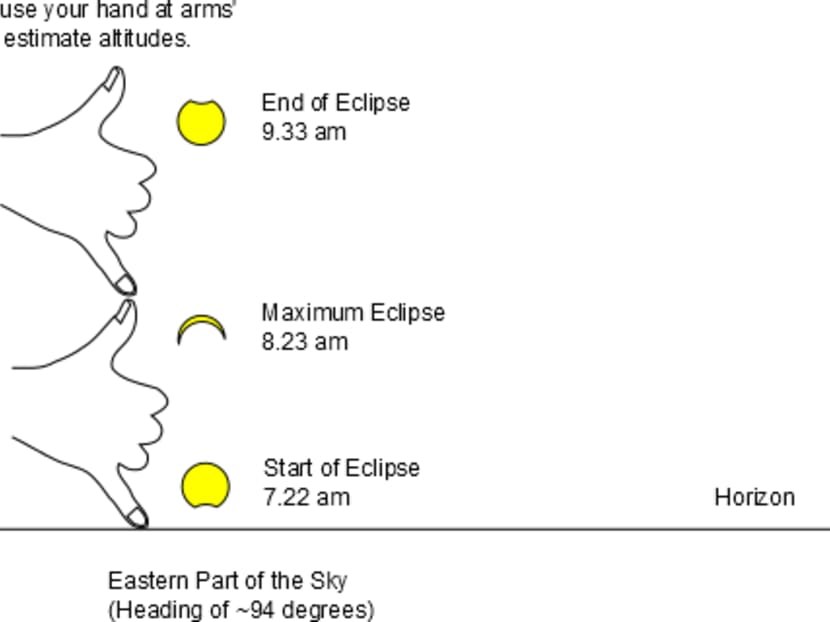
(Photo: Science Centre Singapore)
Between 1700 and 2100, only 146 solar eclipses have been (or will be) visible from Singapore. The last solar eclipse visible from Singapore was on May 10, 2013. But, the eclipse on that day was extremely difficult to view, as it was over shortly after sunrise.
VIEWING THE ECLIPSE SAFELY
Science Centre Singapore warns the public not to look at the sun directly without any form of protection, as it can cause permanent eye injury, including blindness, within a few seconds. The Science Centre added that the effects of eye injury may only be noticed a few hours later, as the retina of the eye has no pain receptors.
Some safe methods of viewing the eclipse include using specially designed solar glasses or through the pinhole projection method. (Click here to view NASA’s how-to-guide on making a pinhole camera at home: http://www.jpl.nasa.gov/edu/learn/project/how-to-make-a-pinhole-camera/)
People who wish to use a telescope or binoculars to view the eclipse, or even take photos or videos, are also advised to use solar filters or glasses for both the device and photographer.
“These filters block out not only most of the visible light, but also ultraviolet and infrared light that can be harmful to your eyes,” Dr Yang explained.
“The filter must be designed for telescope use and must cover the front of the telescope or binoculars,” he added. “Do not use solar filters that cover (only) the eyepiece end as the focused sunlight can heat up the optics and cause it to crack.”
The following are unsafe methods to view the eclipse. (Note: This is not an exhaustive list. When in doubt, stick to solar filters or a pinhole camera):
- Sunglasses (polarised and non-polarised versions)
- Solar film for car and household windows
- Tinted glass
- Photographic negatives
- X-ray film
- CDs/DVDs
- Photographic filters
- Looking at the reflection in a bowl of water or mirror
Following the March 9 solar eclipse, the next solar eclipse visible in Singapore will be on Dec 26, 2019. This solar eclipse will be even more special, as the Sun and Moon will be exactly in line, but the apparent size of the Moon will be smaller than that of the Sun, creating the appearance of a “ring of fire” in the sky. The scientific term for this phenomenon is an “annular eclipse”.
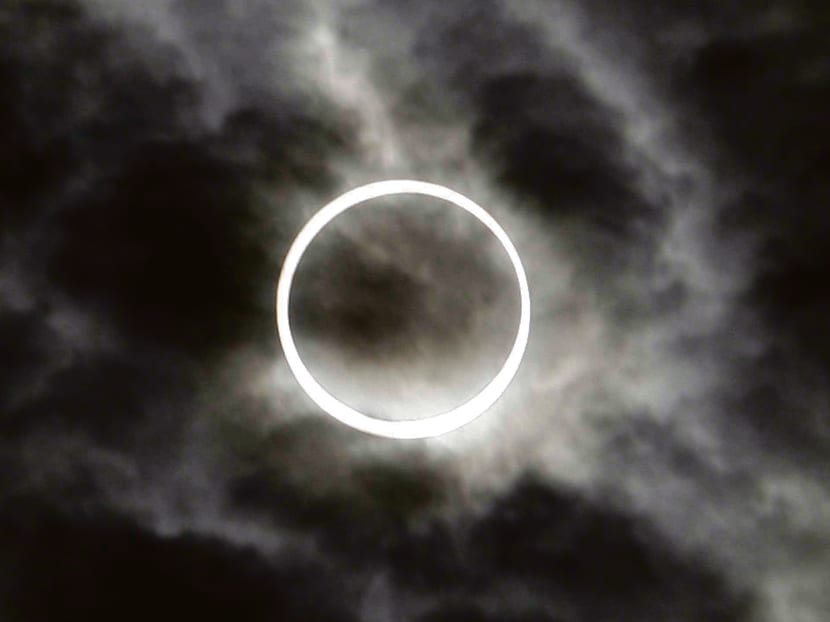
(An annular solar eclipse is seen in the sky over Tokyo Monday, May 21, 2012. Photo: AP)
Of the 146 solar eclipses that have been (or will be visible) from Singapore between 1700 and 2100, only 3 are annular or total solar eclipses. The last total solar eclipse in Singapore was on March 4, 1821, according to the UK Hydrographic Office, then known as Her Majesty's Nautical Almanac Office (HMNAO).
Dr Yang explained that while solar eclipses can occur on earth rather frequently, the path of a solar eclipse only covers a very small part of the planet; and as such for a given location on earth (such as a town or village), solar eclipses, particularly a total solar eclipse, can be very rare.
On March 9, other parts of South-east Asia and the Pacific will also experience solar eclipses to varying degrees. Indonesia, Malaysia and the Philippines for instance will see more than 50 per cent of the sun partially covered, while Cambodia, Myanmar, Vietnam and Thailand will see about 50 per cent partial eclipsed sun. The Indonesian city of Palembang will be one of the few that will witness a total solar eclipse.
UNDERSTANDING SOLAR ECLIPSES
A solar eclipse occurs when the moon casts a shadow on the earth when it comes between the earth and sun. Because the moon is small compared to the sun, its shadow is small so only a small part of the earth will be in shadow.
In the past, total solar eclipses, which can occur once every few hundred years for a given location, would often be associated with omens or the supernatural, said Dr Yang.
Dr Yang’s colleague, Dr Cindy Ng, a Senior Lecturer, explained: “The Sun is the source of light and heat. In the past, people could be shocked when a solar eclipse occurred. Without good knowledge of astronomy, they had absolutely no idea what the circular darkness was, and why it was eating the Sun. They were also unsure if the Sun would later regain its brightness, or be forever lost in darkness. It was an anxious moment to our ancestors, coupled with the fear of losing sunlight forever.”
Today though, Dr Yang said solar eclipses give scientists the opportunity to observe stars in the vicinity of the sun that would otherwise be lost in daylight.
“Such observations have been used to show test the theory of relativity, which predicts that a massive object such as the sun can bend light that passes close to it.”
SOME PLACES WHERE YOU CAN CATCH THE SOLAR ECLIPSE
1. Science Centre Singapore
Time: 7.30 am – 10.00 am
Venue: Fibonacci Terrace, main carpark, Kinetic Garden
Admission: Free
Highlights: On the day itself, Science Centre Singapore will be handing out solar glasses and setting up venuscopes so members of the public can view the solar eclipse safely. The Science Centre will also be doing a live stream of the total solar eclipse from Micronesia. Additionally there will be two special live shows on the sun and eclipses at the Science Centre's digital planetarium (admission charges apply). Learn more: Science Centre's page
Pre-solar eclipse talks: On March 5, Science Centre will also be holding a talk on the eclipse and safe viewing methods. Solar glasses will also be given out at the end of the talk. There will be also be hands-on workshops on making a pinhole projector for eclipse viewing. These workshops may be carried out right after the talks.
2. National University of Singapore
Highlights: NUS' astronomy fraternity will be holding a series of educational activities in conjunction with this special celestial event. Presented by the Department of Physics at the NUS Faculty of Science, there will be public lectures, astrophotography exhibitions, stargazing sessions and of course, the solar eclipse observation session itself. All the events are open to the public for free.
